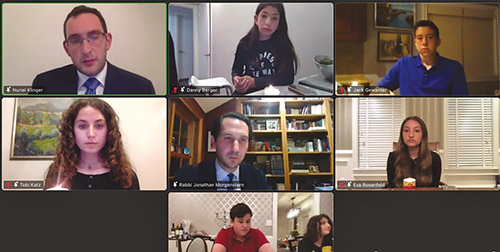





On April 8, the Westchester community joined the Young Israel of Scarsdale’s (YIS) Yom HaShoah Zoom event. Six local teens were invited to light memorial candles in memory of the 6,000,000 who died, including their family members.
The featured speaker was David Bernstein, the historian and guide for YIS’ mission to Poland and the dean of Jerusalem’s Pardes Institute of Jewish Studies. Before making aliyah in 1984, he developed Ramaz Upper School’s unique integrated Jewish and World History curriculum. YIS’ Rabbi Morgenstern noted, “He brings the neshama of the kedoshim to life with incredible scholarship but also with incredible heart and soul.”
Bernstein reflected, “Yom HaShoah is a time to remember the victims, but often that memory gets stuck on their murders and not on their lives. This doesn’t give full honor to their memory. Jews of Eastern Europe, the majority of the victims of the Final Solution to the Jewish Question, had created a community built over centuries that deserves to be remembered. They also responded to modernity in the late 19th and early 20th centuries in various ways and those need to be remembered, as well. Yes, there were Tevyes and Goldas as in Fiddler on the Roof, but there was so much more.”
Bernstein comprehensively condensed eight centuries of Jewish Krakow in the time allotted. From 1200-1600, Poland became the largest Jewish community in the world, and kept that title for three more centuries. In the 1300s, the Jews were expelled across the river to Kazimierz, the historic Jewish quarter until today. The Alta Shul, second oldest shul in Europe, was built in 1407 into the city’s defensive walls, known as a fortress shul. This was the official shul of Krakow, even when there were larger and newer shuls. In 1793, Polish Patriot Tadeusz Kościuszko (as in New York’s Kosciuszko Bridge), leading a Polish revolt against the Russians, visited the “Old Shul.”
Bernstein described the lasting highlights of the great Jews of previous centuries, including Rabbi Moshe Isserles (Rema). His shul and grave still stand off the main square. One example of early 20th century Polish Jewry’s dealing with modernity is the Bais Yaakov movement. Sarah Schenirer’s seminary building for girls still stands along the Vistula River.
Noting Krakow’s proximity to Germany, Bernstein explained how the Nazis began restrictions on Jewish life in 1939. Before the ghetto was formed in 1941, there were 56,000 Jews in Krakow, about 25% of the population, about the same percentage as New York City. In the ghetto, 18,000 were crammed into the space for 3,000. When liquidated, many were sent to nearby Belzec and Plaszow (as in Schindler’s List). Bernstein shared a photograph of the square where Jews gathered for deportation. Since 2004, Ghetto Heroes Square has had a memorial of 70 empty metal chairs.
He continued that after the war, many ironically went to Germany’s DP camps for safety. The Jewish population of Krakow diminished further by communism and anti-Semitism. After 1989, many in Krakow who previously hid their Jewish identity began to resurface. Some told adult children for the first time that they were Jewish or they found out from grandparents on their deathbeds. Others were told they were adopted when a Jewish couple appeared at their door during the war, and asked them to take the child. Bernstein added that the Krakow Jewish community is actually growing.
The JCC was opened in 2008 by Prince Charles, described Bernstein. After an official visit to Auschwitz, while meeting Holocaust survivors, Prince Charles asked, “What can I do for you?” They replied, “We’re not religious, We don’t go to synagogue. We’d like a place to meet.” Returning home, he asked British Jewish leaders to arrange a place for them. The locals meet regularly for classes in Yiddish and Hebrew language and to celebrate Jewish holidays.
Bernstein presented a photograph of the gentrified, Jewish-influenced quarter as a cool, hip place for bars, cafes, boutique hotels and youth hostels, particularly for the urban intellectual elite. The Jewish Studies Department at the Jagiellonian University has grown exponentially since the fall of communism. Locals clean up Jewish cemeteries and put plaques on Jewish sites.
The first new Jewish preschool in Krakow opened in the JCC. Bernstein can’t vouch for the halachic status of these children, but said, “they’re of Jewish descent. They’re receiving Jewish education that was impossible to receive in Krakow for 70 years. While only a sliver of what once existed, there is some Jewish life in Krakow today, more than 30 years ago. It’s testimony to persistence and resilience, which reflects persistence and resilience of Jews all over the world. That’s an important message to be shared.”
By Judy Berger








